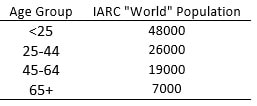MED 6270 assignment 1
Question 1 (13 marks)
Several well-designed and executed epidemiologic studies have implicated exposure to household mould as a potential cause of chronic asthma in a small independent country called the Republic of Avalon (pop. 10,000).
As a member of the provincial disease surveillance group, you are responsible for reporting statistics on chronic asthma. Assume that people who develop chronic asthma due to household mould exposure take several years to recover from the infection.
The following data in Table 1 are the number of new cases of chronic asthma reported to the provincial disease surveillance system for each month in 2012.
The estimated population for Newfoundland and Labrador in 2012 is 513,568 persons.
Table 1. Number cases of new cases chronic asthma reported by month in 2012 for the province of Newfoundland and Labrador
{`Jan Feb Mar Apr May Jun Jul Aug Sept Oct Nov Dec
Total 31 28 72 52 14 17 53 53 49 49 55 19
`}
Using the information above answer the following questions:
- Calculate the incidence risk for 2012 (3 marks).
- Calculate the incidence rate of disease using the approximate methods (include sick in the denominator of the approximate method) (4 marks).
- Is this the best measure to use for the above situation? Why? (3 marks)
- What do you expect to happen to the prevalence of disease in 2013? Why? (3 marks)
Question 2 (35 marks)
Recent survey data indicates that 5% of the population live in households with mould growth. A two-‐ year cohort study was conducted. Thanks to the Republic of Avalon's very low mortality rate and restrictive emigration policies, there is no loss to follow-‐up in either study.
The study recruited 400 persons who lived in houses contaminated with mould ("exposed") and 400 persons who lived in mould-‐free homes ("unexposed"); 50 exposed participants developed chronic asthma, as do 15 unexposed participants.
a. Create a 2 x 2 table for the cohort study to examine the association between household mould and chronic asthma. (4 marks)
b. Calculate the following measures for the study. Be sure to include and interpretation of your answer. (18 marks)
- Calculate the following measures of disease for the study
- Incidence risks (cumulative incidence) for the un-‐exposed (mould free homes), exposed (household with mould), and total study population. (6 marks)
- Incidence Risk Ratio (a.k.a. cumulative incidence ratio) (3 marks)
- Odds ratio (OR) (3 marks)
- Incidence risk difference (a.k.a. cumulative incidence difference, attributable risk) (3 marks)
- Comment on the difference or similarity between the OR and the IRR? (4 marks)
- Are people who live in household with mould significantly more likely to develop chronic asthma than people who live in mould free homes? Show evidence of your conclusion using the odds ratio. (4 marks)
Use the following information in conjunction with your previous answers in answering parts d and e.
A recently identified viral pathogen, Influenza X, has been identified as a potential cause of chronic asthma after infection. The study found that approximately 35% of the population had been exposed to the virus. The risk that a person exposed to Influenza X would develop chronic asthma was 3.75 times greater than for those who had not been exposed to the Influenza X virus and the risk difference was 0.22.
d. Which association provides stronger evidence of a causal link? Why? (explain using Hill’s criteria) (2 marks)
e. In preparation for the next election, the Republic of Avalon's government is seeking a public health success. Assuming that resources and intervention expertise are available to eliminate either household mould or Influenza X, but not both, which of these two exposures should be chosen for the prevention program in order to have the most visible results? What two epidemiologic measure(s) can assist you in this decision? Calculate these and use them to support your decision. (hint: demonstrate what each of these is telling you). Show your calculations. (6 marks)
Question 3 (18 marks)
In a study comparing the prevalence of diagnosed cases of diabetes in several indigenous populations in the circumpolar region, the following data relating to the Athapaskan Indians (Dene) in the Northwest Territories (NWT), Canada and in Alaska, USA, were obtained.

Answer the following questions using the data above
a) Calculate the crude prevalence of diabetes among the populations in NWT and Alaska (4 marks).
b) Calculate the age-standardized prevalence of diabetes among Alaskan and NWT Dene, using the information already given and with the IARC "world" population as a standard (8 marks).

c) What kind of standardization (direct or indirect) has just been done? (2 marks)
d) To do the other kind of standardization, what additional pieces of information are required? Suggest an appropriate "standard". (4 marks)
